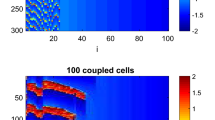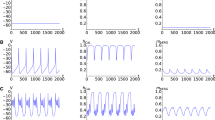Abstract
It has been shown previously that identical spiking cells, incapable of bursting by themselves, may burst under weak diffusive coupling conditions. With stronger coupling, the coupled system reverts to bursting can be recovered by introducing heterogeneity in the model parameters. For a two-cell system, we explain the phenomenon with bifurcation analysis. For larger clusters of coupled cells, we demonstrate by numerical simulation that the phenomenon carries over. In addition, we use a perturbation analysis to deduce the dependence of the heterogeneity parameter used in the bifurcation analysis on the original heterogeneity parameters and the coupling strength. Implications of the phenomenon of emergent bursting are discussed in the context of electrical activity in pancreatic beta cells.
Similar content being viewed by others
References
Bangham, J. A., P. A. Smith and P. C. Croghan (1986). Modeling the beta-cell electrical activity, in Biophysics of the Pancreatic β-Cell, I. Atwater, E. Rojas and B. Soria (Eds), New York: Plenum Publishing Co., pp. 265–278.
Bertram, R., J. Previte, A. Sherman, T. A. Kinard and L. S. Satin (2000). The phantom burster model for pancreatic β-cells. Biophys. J. 79, 2880–2892.
Butera, R. J., J. Rinzel and J. C. Smith (1999). Models of respiratory rhythm generation in the pre-Bötzinger complex: I. Bursting pacemaker neurons. J. Neurophys. 82, 382–397.
Cartwright, J. H. (2000). Emergent global oscillations in heterogeneous excitable media: the example of pancreatic β cells. Phys. Rev. E 62, 1149–1154.
de Vries, G. (1998). Multiple bifurcations in a polynomial model of bursting electrical activity. J. Nonlinear Sci. 8, 281–316.
de Vries, G. and A. Sherman (2000). Channel sharing in pancreatic β-cells revisited: enhancement of emergent bursting by noise. J. Theor. Biol. 207, 513–530.
de Vries, G., A. Sherman and H.-R. Zhu (1998). Diffusively coupled bursters: effects of cell heterogeneity. Bull. Math. Biol. 60, 1167–1200.
Ermentrout, G. B. and N. Kopell (1986). Parabolic bursting in an excitable system coupled with a slow oscillation. SIAM J. Appl. Math. 46, 233–253.
Hindmarsh, J. L. and R. M. Rose (1984). A model of neuronal bursting using three coupled first order differential equations. Proc. R. Soc. London B 221, 87–102.
Hodgkin, A. L. and A. F. Huxley (1952). A quantitative description of membrane current and its application to conduction and excitation in nerve. J. Physiol. (London) 117, 500–544.
Izhikevich, E. M. (2000). Neural excitability, spiking and bursting. Int. J. Bifurcation Chaos 10, 1171–1266.
Jonkers, F. C., J. C. Jonas, P. Gilon and J. C. Henquin (1999). Influence of cell number on the characteristics and the synchrony of Ca2+ oscillations in clusters of mouse pancreatic islet cells. J. Physiol. (London) 520, 839–849.
Kinard, T. A., G. de Vries, A. Sherman and L. S. Satin (1999). Modulation of the bursting properties of single mouse pancreatic β-cells by artificial conductances. Biophys. J. 76, 1423–1435.
Larsson, O., H. Kindmark, R. Bränstrom, B. Fredholm and P.-O. Berggren (1996). Oscillations in KATP channel activity promote oscillations in cytoplasmic free Ca2+ concentration in the pancreatic β cell. Proc. Natl. Acad. Sci. USA 93, 5161–5165.
Liu, Y. J., A. Tengholm, E. Grapengiesser, B. Hellman and E. Gylfe (1998). Origin of slow and fast oscillations of Ca2+ in mouse pancreatic islets. J. Physiol. (London) 508, 471–481.
Manor, Y., J. Rinzel, I. Segev and Y. Yarom (1997). Low-amplitude oscillations in the inferior olive: a model based on electrical coupling of neurons with heterogeneous channel densities. J. Neurophys. 77, 2736–2752.
Nayfeh, A. H. (1973). Perturbation Methods, New York: Wiley.
Rinzel, J. (1985). Bursting oscillations in an excitable membrane model, in Ordinary and Partial Differential Equations, Lecture Notes in Mathematics 1151, B. D. Sleeman and R. J. Jarvis (Eds), New York: Springer, pp. 304–316.
Rorsman, P. and G. Trube (1986). Calcium and delayed potassium currents in mouse pancreatic β-cells under voltage clamp conditions. J. Physiol. (London) 374, 531–550.
Sherman, A. (1994). Anti-phase, asymmetric and aperiodic oscillations in excitable cells—I. Coupled bursters. Bull. Math. Biol. 56, 811–835.
Sherman, A. and J. Rinzel (1992). Rhythmogenic effects of weak electrotonic coupling in neuronal models. Proc. Natl. Acad. Sci. USA 89, 2471–2474.
Sherman, A., J. Rinzel and J. Keizer (1988). Emergence of organized bursting in clusters of pancreatic β-cells by channel sharing. Biophys. J. 54, 411–425.
Smith, P. A., F. M. Ashcroft and P. Rorsman (1990). Simultaneous recordings of glucose dependent electrical activity and ATP-regulated K+-currents in isolated mouse pancreatic β-cells. FEBS Lett. 261, 187–190.
Smolen, P., J. Rinzel and A. Sherman (1993). Why pancreatic islets burst but single β cells do not: the heterogeneity hypothesis. Biophys. J. 64, 1668–1680.
Author information
Authors and Affiliations
Corresponding author
Rights and permissions
About this article
Cite this article
de Vries, G., Sherman, A. From spikers to bursters via coupling: Help from heterogeneity. Bull. Math. Biol. 63, 371–391 (2001). https://doi.org/10.1006/bulm.2001.0228
Received:
Accepted:
Issue Date:
DOI: https://doi.org/10.1006/bulm.2001.0228




